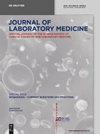在无细胞DNA中分析疾病和组织特异性表观遗传特征
IF 1.8
4区 医学
Q4 MEDICAL LABORATORY TECHNOLOGY
引用次数: 3
摘要
摘要程序性细胞死亡、细胞意外降解和主动挤出不断导致几乎所有细胞和组织类型的DNA片段释放到人体体液中。人们普遍认为,这些无细胞DNA(cfDNA)分子保留了细胞类型特异性的遗传和表观遗传学特征。特别地,血浆或血清中的cfDNA已被用于分子诊断。目前临床上实施的液体活检方法主要基于检测来自健康和患病细胞的cfDNA分子的遗传差异。由于携带突变的cfDNA分子相对于总cfDNA库的比例较低,以及所用技术的检测极限,它们的诊断潜力仅限于涉及基因改变的病理学。最近,研究工作转向了cfDNA分子的表观遗传学特征,发现单个cfDNA分子起源的组织可以从表观遗传学特性中推断出来。例如,甲基化模式、核小体或转录因子结合位点占用、片段大小分布或片段末端基序和组蛋白修饰的分析确定了单个cfDNA分子的来源细胞或组织。通过这种起源组织分析,可以估计不同组织对体液中总cfDNA库的贡献,并发现细胞死亡(病理状况)增加的组织,将液体活检的组合扩展到遗传学之外,并扩展到广泛的病理学,如自身免疫性疾病、心血管疾病和炎症,等等。在这篇综述中,我们概述了起源组织方法的现状,并重点介绍了如何充分利用液体活检的潜力,实现具有广泛临床应用的微创筛查方法。本文章由计算机程序翻译,如有差异,请以英文原文为准。
Profiling disease and tissue-specific epigenetic signatures in cell-free DNA
Abstract Programmed cell death, accidental cell degradation and active extrusion constantly lead to the release of DNA fragments into human body fluids from virtually all cell and tissue types. It is widely accepted that these cell-free DNA (cfDNA) molecules retain the cell-type specific genetic and epigenetic features. Particularly, cfDNA in plasma or serum has been utilized for molecular diagnostics. The current clinically implemented liquid biopsy approaches are mostly based on detecting genetic differences in cfDNA molecules from healthy and diseased cells. Their diagnostic potential is limited to pathologies involving genetic alterations, by the low proportion of cfDNA molecules carrying the mutation(s) relative to the total cfDNA pool, and by the detection limit of employed techniques. Recently, research efforts turned to epigenetic features of cfDNA molecules and found that the tissue-of-origin of individual cfDNA molecules can be inferred from epigenetic characteristics. Analysis of, e.g., methylation patterns, nucleosome or transcription factor binding site occupancies, fragment size distribution or fragment end motifs, and histone modifications determined the cell or tissue-of-origin of individual cfDNA molecules. With this tissue-of origin-analysis, it is possible to estimate the contributions of different tissues to the total cfDNA pool in body fluids and find tissues with increased cell death (pathologic condition), expanding the portfolio of liquid biopsies beyond genetics and towards a wide range of pathologies, such as autoimmune disorders, cardiovascular diseases, and inflammation, among many others. In this review, we give an overview on the status of tissue-of-origin approaches and focus on what is needed to exploit the full potential of liquid biopsies towards minimally invasive screening methods with broad clinical applications.
求助全文
通过发布文献求助,成功后即可免费获取论文全文。
去求助
来源期刊

Journal of Laboratory Medicine
Mathematics-Discrete Mathematics and Combinatorics
CiteScore
2.50
自引率
0.00%
发文量
39
审稿时长
10 weeks
期刊介绍:
The Journal of Laboratory Medicine (JLM) is a bi-monthly published journal that reports on the latest developments in laboratory medicine. Particular focus is placed on the diagnostic aspects of the clinical laboratory, although technical, regulatory, and educational topics are equally covered. The Journal specializes in the publication of high-standard, competent and timely review articles on clinical, methodological and pathogenic aspects of modern laboratory diagnostics. These reviews are critically reviewed by expert reviewers and JLM’s Associate Editors who are specialists in the various subdisciplines of laboratory medicine. In addition, JLM publishes original research articles, case reports, point/counterpoint articles and letters to the editor, all of which are peer reviewed by at least two experts in the field.
 求助内容:
求助内容: 应助结果提醒方式:
应助结果提醒方式:


